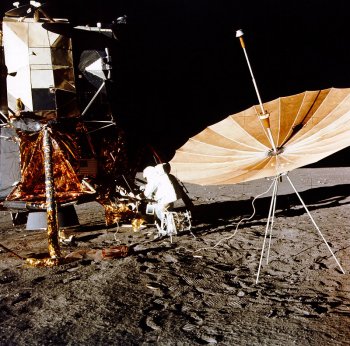Apollo 12

Al Bean setting up experiments on the Moon's surface. The Apollo 12 erectable S-band antenna is in the foreground.
Apollo: 7|8|9|10|11|12 | 13|14|15|16|17
Apollo 12 was the sixth manned mission of the Apollo
Project and the second to land on the Moon.
Apollo 12 was intended to build on the success of Apollo 11, with the added goal of achieving a precision lunar landing. Apollo 12 began dramatically. Astronaut Gordon was so convinced that lightning storms would delay the launch by a day that he fell asleep during the countdown. In fact liftoff went ahead on schedule, but as the Saturn V passed through a low cloud a bolt of lightning discharged through the rocket to the ground. Later in the first minute of flight the Saturn V was struck again. Safety mechanisms turned off most of the power in the Command and Service Module (CSM) but it was manually restored by the crew and the flight continued. For the first time, the S-IVB booster was reignited to make an evasive maneuver.
Following docking of the CSM and Lunar Module (LM), the LM was entered to make sure the lightning hadn't damaged any systems. After the CSM engine fired twice to enter lunar orbit, the LM separated and descended to a pinpoint landing on the Ocean of Storms, less than 180 meters from Surveyor 3 which had soft-landed on the Moon in April 1967.
Astronauts Conrad and Bean performed two moonwalks. During the first, the astronauts set up the Apollo Lunar Surface Experiments Package (ALSEP) and positioned a color TV camera to provide the color transmissions from the lunar surface. However, Bean allowed direct sunlight to enter the camera's lens which damaged its vidicon tube and rendered it useless; television viewers on Earth were able to see the astronauts step onto the Moon but little else. During a second moonwalk, the astronauts walked about 1.5 kilometers collecting lunar samples and removing parts of Surveyor 3 for return to Earth. For the first time, the astronauts documented each sample they took, including the first double-core tube sample of lunar soil. Later laboratory examination revealed that the Surveyor 3 parts harbored bacteria that had survived 19 months of extreme temperatures, dryness, and the near-vacuum of the lunar environment.
Conrad inadvertently carried a Playboy photo to the Moon; it had been planted by a NASA employee and Conrad came across it unexpectedly on the lunar surface while flipping through his mission checklist. For the first time, lunar dust tracked into the LM proved to be a problem. Since the dust became weightless after liftoff from the Moon, the astronauts had trouble breathing without their helmets. For the first time, the LM was fired back toward the Moon after its occupants transferred to the CSM. Intrepid slammed into the Moon at more than 8,000 kilometers per hour with a force equivalent to an explosion of 9,000 kilograms of TNT. The resulting artificial moonquake registered on the seismometer that the astronauts had left on the surface, providing valuable data on the Moon's internal makeup. Some lunar dust found its way into the CSM requiring the astronauts to clean air filter screens every few hours. The splashdown, at 15g, was the hardest ocean-landing ever recorded – enough to jar a 16-millimeter camera from its mounting and hit Al Bean on the head.
| commander | Charles Conrad, Jr. |
| lunar module pilot | Alan Bean |
| command module pilot | Richard Gordon |
| call signs | CM: Yankee Clipper, LM: Intrepid |
| launch | Nov 14, 1969; 16:22:00 UTT (11:22:00 am EST) Kennedy Space Center Launch Complex 39A |
| lunar landing | Nov 19, 1969; 6:54:35 UT (1:54:35 am EST) |
| landing site | Oceanus Procellarum (Ocean of Storms); 3.01 S, 23.42 ) |
| EVA duration | 7 h 45 min EVA 1: 3 h 55 min, EVA 2: 3 h 50 min |
| mass of lunar rocks collected | 34.3 kg |
| time on lunar surface | 31 h 31 min |
| mission duration | 244 h 36 min 24 s |
| splashdown | Nov 24, 1969; 20:58:24 UT (3:58:24 pm EST) |
| retrieval site | Pacific Ocean 15° 47' S, 165° 9' W |
Highlights



